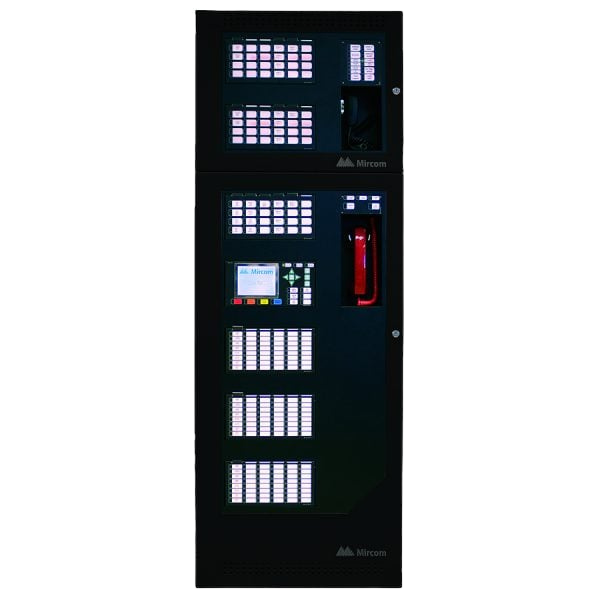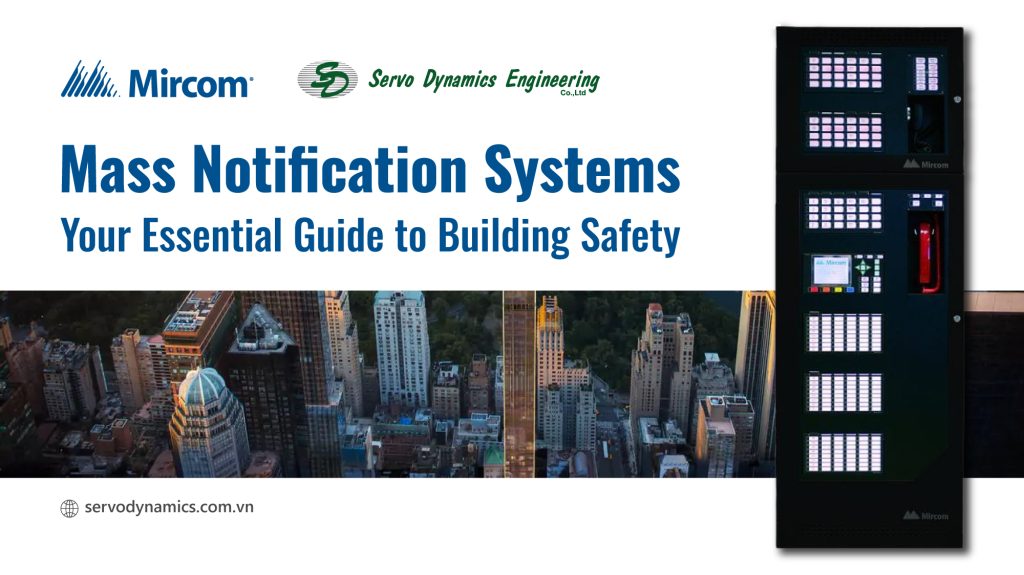Fire & Safety
Mass Notification Systems: Your Essential Guide to Building Safety
Mass Notification Systems (MNS) are becoming increasingly popular for businesses and organizations of all sizes. Why? They offer a wide range of benefits for safety and cost-effectiveness, alongside impressive flexibility and scalability. These integrated “mass communications” solutions bring together various components, often including a traditional fire alarm system, and can be as simple or complex as your specific environment requires.
With advancements in technology and new code requirements, such as NFPA 72, Chapter 24, it’s understandable if business owners, facility managers, and safety directors feel a bit confused, even if they know a Mass Notification System should be a vital part of their safety plans.
Whether you’re considering implementing a Mass Notification System for the first time or want to ensure your current system is up-to-date, refreshing your knowledge of the basics of mass notification is a smart move for your building’s overall safety.
What is a Mass Notification System?
A Mass Notification System (MNS) is far more than just a simple alarm. It’s a smart solution that delivers real-time information and instructions to everyone within a building, area, location, or facility. This system communicates flexibly through:
- Visual signals: Think bright light panels, display screens, or flashing lights that are easy to see.
- Text messages: Sent via phone, email, or displayed on electronic boards.
- Graphics and images: These clearly illustrate situations or provide easy-to-understand instructions.
How a Mass Notification System Boosts Fire Safety Beyond Traditional Alarms
A Mass Notification System (MNS) goes far beyond the basic functions of a traditional fire alarm. While a standard fire alarm system is crucial for alerting people to a fire and instructing them to evacuate, an MNS offers a more advanced, flexible, and targeted approach to fire safety communication, ensuring everyone gets the right message at the right time.
Clearer, More Targeted Fire Communication
Imagine a fire breaks out. A traditional alarm might simply sound a loud bell or siren. But with a Mass Notification System, you can do so much more:
- Specific Instructions: Instead of just an evacuation signal, your MNS can broadcast precise instructions. For example, it can direct occupants to the safest exit route, tell them which areas to avoid, or even guide them to designated assembly points. This level of detail is impossible with a standard fire alarm and can be life-saving.
- Targeted Messaging: What if the fire is confined to one wing or floor? An MNS allows you to send messages to specific zones or areas, rather than alarming the entire building unnecessarily. This prevents panic in unaffected areas and allows emergency responders to focus on the affected zone more efficiently.
- Multiple Communication Channels: Fire emergencies can be chaotic. An MNS ensures your message reaches everyone through various methods:
- Loudspeakers and voice announcements: Providing clear, spoken instructions.
- Visual displays (strobe lights, LED signs, video screens): Crucial for noisy environments or for individuals who are hearing impaired, ensuring they receive critical fire alerts and evacuation directions.
- Text messages and emails: Reaching staff and visitors who may be off-site or in less audible areas. This redundancy means your critical fire safety messages are more likely to be seen and understood by everyone.
Adapting to Complex Fire Scenarios
Fire situations aren’t always straightforward. An MNS provides the flexibility to adapt:
- Dynamic Guidance: In a rapidly changing fire event, initial instructions might need updating. An MNS allows you to broadcast new information instantly, helping occupants adjust their actions (e.g., “Do not use stairwell A, use stairwell B instead”).
- Preventing Misinformation: In a crisis, rumors can spread quickly. An MNS ensures that official, accurate information about the fire or evacuation status is communicated directly, preventing panic caused by false alarms or misinformation.
By enhancing traditional fire alarms with sophisticated communication capabilities, a Mass Notification System becomes an indispensable tool for protecting lives and property during fire emergencies. It empowers building occupants with clear, actionable information, significantly improving their chances of a safe outcome.
Integrating Voice-Enabled Fire Alarms with Mass Notification Systems
Voice-enabled fire alarm systems can actually form the cornerstone of an integrated mass notification solution. These systems can instantly broadcast live or pre-recorded messages in buildings, institutional and campus environments, and other facilities. A universal message, or specific messages tailored to certain areas, buildings, floors, or rooms, can be delivered through the fire alarm system.
A major advantage of this approach is its cost-effectiveness. It allows a facility to leverage existing fire and life-safety systems and infrastructure. Plus, the fire alarm system provides the code-required emergency backup power to keep the system running if the primary source is compromised. It also offers a high level of survivability, meaning networked fire alarm control units can continue operating even if a fault or other issue occurs within the system.
Communication Methods for Your Mass Notification System
While many people today associate a Mass Notification System with text alerts, a comprehensive system usually involves multiple communication modes. These can include:
- Audio and/or visual notifications from a fire alarm system.
- Email notifications.
- Automated phone calls (like a reverse 911 call).
- Visual messaging boards.
A Mass Notification System can also incorporate simple updates to TVs or LCDs in elevators, lobbies, or other devices that building occupants often rely on for valuable information.
For larger buildings and campuses, outdoor loudspeakers or arrays can sound siren notifications or deliver live or automated messages. A Mass Notification System can also be used for general paging. However, NFPA 72: National Fire Alarm and Signaling Code includes a provision requiring all paging or non-alarm events to be overridden during a fire alarm activation or when required by the Emergency Response Plan’s Mass Notification System activation.
The Central Control Unit for Fire Alarms and Mass Notification Systems
The main control panel is the “brain” of the fire alarm system. It can be installed at the building’s front entrance or in an electrical room. If the panel is in a secure room, like an electrical room, there’s typically a smaller panel called an annunciator at the front entrance.
Fire alarm control panels continuously monitor and display the system’s status. For most scenarios, there are three possible states:
- Normal: This means all appliances, devices, circuitry, and wiring are functioning correctly, and there are no active alarms.
- Alarm: This status indicates an active alarm.
- Trouble: If an open or short circuit develops in the wiring connecting initiating devices to the fire alarm panel, or if the system’s phone line connection isn’t working, the system will enter a “trouble” state, which the control panel will display.
Initiating devices are what trigger alarms. Just like alarm panels, they can be either addressable or non-addressable. Some initiating devices, like water flow switches, are traditionally non-addressable but connect with addressable modules. These controls can have specific addresses that allow them to communicate with addressable systems.
There are many types of initiating devices. In addition to water flow switches, initiating devices can also include:
- Pull stations
- Duct detectors
- Smoke detectors
- Beam detectors
- Heat detectors
- Tamper switches
- Air aspirating detectors
Conventional panels represent a building as a series of regions known as detection zones. When a smoke detector or pull switch in a zone activates, the electrical current to the fire alarm panel changes. The control panel then indicates that a device somewhere in that zone has been activated.
Typically, heat detectors work similarly to an electrical fuse; they contain a heat-sensitive eutectic alloy. When a specific temperature is reached, the alloy turns from a solid to a liquid, which in turn triggers the alarm. Ionization smoke detectors generally contain two chambers.
Integrating Fire Alarm Systems with Other Technologies for Optimal Efficiency
Sometimes, building codes mandate the integration of fire alarm systems with other technologies. However, in other cases, integration is optional and voluntary, such as connecting with lighting systems, HVAC systems, door locks, and security systems. While these systems historically required independent network communications, they can now operate on a shared infrastructure, saving you money and streamlining processes.
Some examples of functions and systems commonly interfaced with fire alarm systems include:
- Extinguishing systems like automatic sprinkler systems
- Power interruption and elevator recall
- Smoke management
- HVAC fan and damper controls
- Door unlocking and door release
- Security systems
- Mass Notification Systems
- Monitoring of fire extinguishers
According to the National Fire Alarm and Signaling Code, some of the above are “fire safety functions” designed to improve occupant life safety or control the spread of fire. You can choose to integrate other functions or systems for various reasons, such as operational benefits, information sharing, and cost savings.

Introducing an Advanced Fire and Emergency Communication Solution: Mircom FleX-Net MNS
As the demand for safety and emergency notification solutions continues to grow, choosing a reliable system is paramount. The Mircom FleX-Net MNS is a “next-generation” modular network system specifically designed to meet the most demanding requirements in fire protection and emergency communications.
FleX-Net MNS offers exceptional system configuration flexibility, with a wide array of cabinet and size options for control and annunciation needs. Thanks to its modular design, this system provides almost limitless freedom to set up local, group, or global control and notification wherever needed. Notably, you can configure up to 7 LCD/control chassis in a single node, optimizing both monitoring and operational capabilities.
The Mircom FleX-Net Series is a powerful, intelligent, and networkable fire alarm solution built with multiple levels of flexibility to handle virtually any application, from detection and control to notification and emergency communications. Key features such as fire detection & alarm, audio/voice evacuation, BACnet, Boolean logic, networking, and graphical workstations enable this modular solution to fit everything from the simplest setups to the most complex solutions.
Furthermore, with the addition of Advanced Protocol (AP), Fire/CO detection, and 520 Hz support on both the addressable loop and through the audio/voice evacuation, Mircom FleX-Net MNS is poised to take you even further into the future with expanded capabilities. This system supports multiple intelligent protocols, including MIX-4000 Devices, Advanced Protocol (AP), and Classic Loop Interface Protocol (CLIP).
FleX-Net MNS stands out with these key highlights:
- Real-time Information Delivery: Provides immediate, up-to-date information during emergencies, ensuring occupants are well-informed and can respond appropriately.
- Dynamic Response: The system automatically adapts as emergencies evolve, ensuring the most relevant information is always communicated.
- Advanced Hardware and Software: Utilizes the industry’s most advanced technology to provide reliable and clear audible and visual notification, live voice instruction, and Internet-based text messaging.
- Integration Capabilities: Can be easily integrated with other public safety systems for comprehensive emergency communications across wide area networks.
- Compliance with Standards: UL 2572 listed for Mass Notification System and complies with NFPA 72-2019 and UFC/DOD standards for emergency communications systems. It is also UL Listed for Smoke Control (UUKL).
- Storage and Activation of Pre-programmed Messages: Allows for quick, efficient communication during emergencies.
- One-Way and Two-Way EVACS Capability: Facilitates both outgoing emergency communications and incoming feedback or requests for assistance.
- Synchronized Evacuation Zone Signalling: Ensures all areas of a building receive emergency notifications simultaneously.
- Large LCD Displays: Provide clear, easy-to-read information and instructions during emergencies.
- Remote Diagnostics: Built-in web server and standard Ethernet port in every node allow for remote monitoring and troubleshooting.
- Supports Over 250,000 Points on a Single Network: Ensures comprehensive coverage for even the largest facilities.
Additionally, QAA Series amplifiers have been listed as compatible for 520Hz low-frequency operation with select System Sensor and Gentex speakers and speaker/strobes, ensuring optimal effectiveness in message delivery.

Servo Dynamics Engineering – Your Authorized Mircom Distributor in Vietnam
To ensure that customers in Vietnam can effectively access and implement leading safety solutions, such as the Mircom FleX-Net FX-2000N Series Mass Notification System, Servo Dynamics Engineering proudly serves as the official authorized distributor for Mircom in the Vietnamese market.
With extensive experience and deep technical expertise, Servo Dynamics Engineering is committed to providing high-quality, genuine Mircom products, along with professional consultation, installation, and technical support services. We understand the specific needs of each project, enabling us to help you select and optimize the most suitable safety system, ensuring maximum protection for people and assets.

 Tiếng Việt
Tiếng Việt



